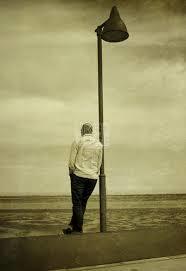Height of the lamp post
 John is walking by the edge of a road at night.
John is walking by the edge of a road at night.
There is a lamp post besides the road, which is working. The nearest point on the road to the lamp post is P .
His shadow is produced due to the light from the lamp post.
When he walks from point R to point Q , he notices that the length of his shadow at point R was 2 3 times the length of his shadow at point Q .
Next, when John walks from point Q to point P , he further notices two things.
1 ) Q is halfway between P and R .
2 ) The length of his shadow when he was at point Q and the distance between him and the pole at point P are equal.
On the basis of the data collected by John, find the height of the lamp post (in meters), if his height is 1 . 8 m .
Details And Assumptions
∙ P , Q and R are co-linear and are on the edge of the road.
∙ Ignore any light other than that coming from the lamp post in question.
∙ Source : Problems plus in IIT Mathematics by Asit Das Gupta.
∙ Image Credit : Red Edge
The answer is 4.156.
This section requires Javascript.
You are seeing this because something didn't load right. We suggest you, (a) try
refreshing the page, (b) enabling javascript if it is disabled on your browser and,
finally, (c)
loading the
non-javascript version of this page
. We're sorry about the hassle.
3 solutions
Let
S - length of shadow at point Q
d - distance between points P and Q, and Q and R.
The imaginary line where the points P, Q and R lies at S distance from the lamp post with P being the closest to the lamp post. So, the distance between the lamp post and point Q is S 2 + d 2 . Since point R is 2d away from P, the distance between the lamp post and point R is S 2 + 4 d 2 By similar triangles at point Q, we get:
S 2 + d 2 + S H = S 1 . 8 ; H = S 1 . 8 ( S 2 + d 2 + S )
Then at point R:
S 2 + 4 d 2 + 2 3 S H = 2 3 S 1 . 8 ; H = S 1 . 2 ( S 2 + 4 d 2 + 2 3 S )
By equating the equations obtained above, we get the relation:
d 2 = 7 5 S 2
Finally, by substituting the relation to any of the above equations, we obtain:
H = S 1 . 8 ( S 2 + 7 5 S 2 + S ) = S 1 . 8 S ( 7 1 2 + 1 ) = 4 . 1 5 6
Answer
= [ (√7 + √12) / √7 ] × 1.8
= 4.15675322 m
Let PR = 2x and the shadows' length be y (also the same as the lamp post distance to the nearest roadside at P) and 1.5y.
√( y² + x² ) / y = √( y² + (2x)² ) / 1.5y
(9/4) × ( y² + x² ) = ( y² + 4x² )
9y² + 9x² = 4 × ( y² + 4x² ) = 4y² + 16x²
5y² = 7x²
y / x = √7 / √5
If lamp post height = L, then the ratio is
L / 1.8 = [ √( y² + x² ) + y ] / y = [ √( y² + (2x)² ) + 1.5y ] / 1.5y
L / 1.8 = ( √12 + √7 ) / √7 = ( √27 + 1.5√7 ) / 1.5√7
L = 1.8 × ( 1 + √(12/7) )
= 4.15675321 m
= 13' 8" ft
It would be easier to explain if I could post images here, but I don't. I hope some one can help me.
Let:
When the man is at Q, we notice that the triangle of the tip of his shadow A, the top of his head B and Q ( △ A B Q ) is similar to that of A, the top of the lamp post C and the bottom of the lamp post D (\triangle ACD).
Therefore,
B Q C D = A D A Q
We note that C D = H , B Q = h , A Q = a and A D = A Q + D P 2 + P Q 2 = a + a 2 + d 2 .
⇒ h H = a a + a 2 + d 2 = 1 + 1 + ( a d ) 2
Similarly, when he is at R,
⇒ h H = 2 3 a 2 3 a + a 2 + ( 2 d ) 2 = 1 + 3 2 1 + 4 ( a d ) 2
Equating the two equation, and let x = a d
1 + 1 + x 2 = 1 + 3 2 1 + 4 x 2
3 1 + x 2 = 2 1 + 4 x 2
9 + 9 x 2 = 4 + 1 6 x 2 ⇒ x 2 = 7 5
SInce h H = 1 + 1 + ( a d ) 2
⇒ H = h ( 1 + 1 + x 2 ) = 1 . 8 ( 1 + 1 + 7 5 ) = 1 . 8 ( 1 + 7 1 2 ) = 4 . 1 5 6